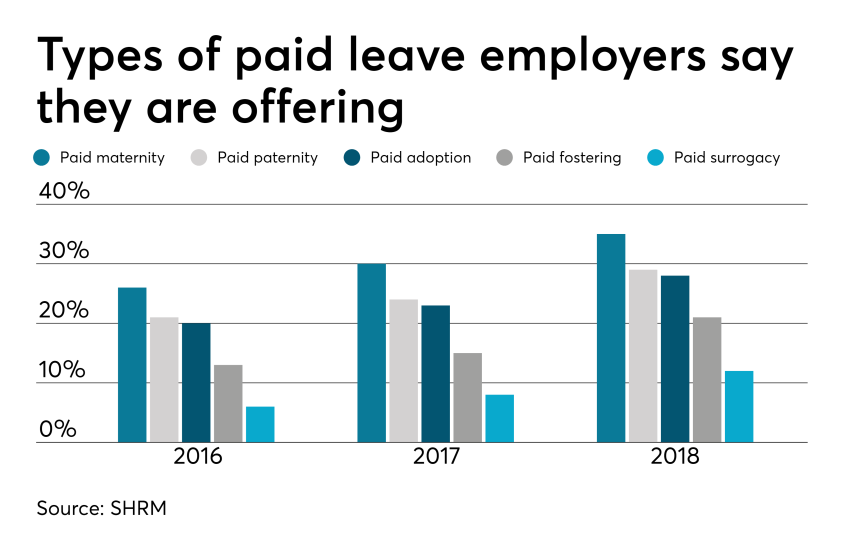4 pitfalls of paid leave and how clients can avoid them
Employers are using paid leave options to help boost their employee benefits packages in efforts to better attract and retain talent. Read the following blog post from Employee Benefit Advisor for 4 common pitfalls of paid leave and how employers can avoid them.
 Smart employers are boosting their benefits packages with paid family leave — the most coveted work perk among all generations. In today’s low unemployment environment, paid leave benefits can be a huge differentiator in attracting and retaining talent.
Smart employers are boosting their benefits packages with paid family leave — the most coveted work perk among all generations. In today’s low unemployment environment, paid leave benefits can be a huge differentiator in attracting and retaining talent.
But some employers are getting themselves into trouble in the process, facing accusations of gender discrimination or improper use of leave.
Here are four potential pitfalls of paid leave, and how employers can avoid them.
1. Be careful what you call “maternity leave.”
Employers have long been granting leave for new moms in the form of disability coverage. In fact, the top cause of short term disability is pregnancy. Disability insurance usually grants new moms six to eight weeks of paid leave to recover from childbirth.
Because this coverage applies to the medical condition of recovering from childbirth, it shouldn’t be lumped in with bonding leave.
Guidance from the Equal Employment Opportunity Commission says leave granted for new moms for bonding must also be extended to new dads, so separating disability leave from bonding leave is crucial to avoiding gender discrimination.
2. Don’t make gender assumptions.
The amount of bonding time for new parents after birth, adoption or fostering must be granted equally for men and women. Companies that don’t provide the same amount of paid leave for men and women may find themselves in a discrimination lawsuit.
It’s not just the time away from work that matters, but also the return-to-work support provided. If new moms are granted temporary or modified work schedules to ease the transition back to work, new dads must also have access to this.
Some companies may choose to differentiate the amount of leave and return-to-work support for primary or secondary caregivers. That’s compliant as long as assumptions aren’t made on which gender is the primary or secondary caregiver.
The best way to avoid potential gender discrimination pitfalls is to keep all parental bonding and related return-to-work policies gender neutral.
3. Avoid assuming the length of disability.
Be careful about assuming the length of time a new mom is disabled, or recovering medically, after birth. Typical coverage policies allot six to eight weeks of recovery for a normal pregnancy, so assuming a new mom may be out for 10 weeks might be overestimating the medical recovery time, and under-representing the bonding time, which must be gender neutral.
4. Keep up with federal, state and local laws.
Mandated leave laws are ever-evolving, so employers should consistently cross-check their policies with state and local laws. For instance, do local paid leave laws treat adoption the same as birth? Are multistate employers compliant? What if an employee lives in one state but works in another: Which state’s leave policies take precedence?
Partnering with a paid leave service provider can mitigate the risk of improperly administering leave. Paid leave experts can help answer questions, review guidelines and provide information regarding job-protecting medical or family leave.
They can also help flag potential pitfalls, ensuring leave requests from all areas of your company are managed uniformly and in accordance with state and federal laws, including the EEOC.
SOURCE: Bennett, A. (12 September 2019) "4 pitfalls of paid leave and how clients can avoid them" (Web Blog Post). Retrieved from https://www.employeebenefitadviser.com/list/4-pitfalls-of-paid-leave-and-how-clients-can-avoid-them
U.S. Jobs Increase by 130,000 in August
According to a recent report from the Bureau of Labor Statistics (BLS), U.S. employers added 130,000 jobs this past August and the unemployment rate stayed unchanged at 3.7 percent for the third month in a row. Read this article from SHRM to learn more.
U.S. employers added 130,000 jobs in August, coming in below economists' expectations, and the unemployment rate held at 3.7 percent for the third straight month, according to the latest Bureau of Labor Statistics (BLS) report.
July's employment total was revised down from 164,000 new jobs to 159,000. In the past three months, job gains averaged 156,000 a month after revisions.
"Today's jobs report shows slowing private-sector job growth and slowing wage growth, which—while expected this late in the recovery—is somewhat disappointing after the rapid gains of the past two years," said Julia Pollak, a labor economist at employment marketplace ZipRecruiter.
On Sept. 5, the ADP Research Institute and Moody's Analytics reported private-sector growth of 195,000 new jobs, better than economists' expectations of about 160,000 jobs.
"Despite the slower growth in jobs added, labor force participation did perk up, a sign that the healthy labor market is still drawing in workers from the sidelines," said Glassdoor senior economist Daniel Zhao.
The labor force participation rate—which includes people who are working and those looking for work—ticked up to 63.2 percent, one of its highest readings in years. The proportion of the population currently employed is at 60.9 percent, its highest point since December 2008. And the employment-to-population ratio for workers aged 25-54 reached 80 percent for the first time since January 2008.
Zhao said that the increases signal that the tightness of the labor market is putting upward pressure on labor force participation despite an aging population pulling it down.
Michael Stull, senior vice president at the staffing and recruiting firm Manpower North America, said other positive takeaways from the report are better than expected wage growth and strong hiring in the professional and business, financial and health care sectors.
Job gains in August were led by professional and business services (37,000 new jobs), which includes many technology jobs and the nation's booming health care industry (23,900). Other industries showing gains include finance (15,000) and construction (14,000).
"Health care and professional services have both grown strongly across 2019, carrying the labor market despite weakness in the goods-producing sectors," Zhao said. "Additionally, the increase in temporary help services [15,400 jobs] is a good sign that employers are not cutting back on the most flexible parts of their workforces in the face of recession chatter."
However, Pollak noted that the BLS reported that the private sector only added 96,000 jobs, marking a slowdown from the pace of job growth over the last two years.
Industries like mining and manufacturing are struggling. Mining employment fell by 5,600 jobs and manufacturers have seen a marked slowdown in job creation, with only 3,000 jobs added in August. "In 2018, manufacturing job growth exceeded 10,000 jobs in 11 of 12 months, but this year job growth has been below 10,000 or even negative in six of eight months," Pollak said. "Trade policy uncertainty and a global manufacturing slowdown seem to have brought the 2017-2018 manufacturing boom to a halt."
The retail sector lost 11,000 jobs in August, continuing a trend of month-over-month declines for the seventh consecutive month. "Despite strong consumer spending, increasing labor costs and the rise of e-commerce are keeping retail hiring down even as we begin to enter the holiday hiring season," Zhao said. "We'll be watching the next few reports for signs that the holiday retail hiring season has slowed or that the latest round of tariffs are having a larger effect on the retail industry."
Juiced by Census Hires
U.S. jobs data is now—and will for some time be—inflated by a temporary spike in government hiring for 2020 Census workers. The federal government added 28,000 workers (excluding U.S. Post Office hires) to its payrolls in August. The majority of those—25,000 temporary workers—will go door-to-door over the next several weeks to verify addresses ahead of the 2020 count.
The Census Bureau expects to hire about 40,000 people for this preliminary duty and about 500,000 workers next year for the actual canvassing.
Unemployment Stays Low
The BLS data showed that the national unemployment rate remained below 4 percent for the 18th consecutive month. The number of unemployed people held at 6 million.
"The unemployment rate remains near its lowest level in 50 years, again signaling the strength of the labor market for workers as the number of job openings continues to exceed the number of unemployed workers," Zhao said.
The number of long-term unemployed (those jobless for 27 weeks or more) rose from 1.1 million to 1.2 million in August and accounted for 20.6 percent of the unemployed.
The U-6 unemployment rate—a broader measure capturing both the unemployed, underemployed and those too discouraged to seek work—continued its long decline and held at 7.3 percent for the second month in a row. There were 467,000 discouraged workers in August, about the same as a year ago.
"There are still more discouraged workers than we would expect, given the low unemployment rate," Pollak said. "Discouraged workers are those who are out of work but have not applied for a job in the past four weeks because they think there are none available or none for which they qualify," she explained. "If there were fewer discouraged workers, labor force participation and employment rates would be higher, and more vacancies would be filled."
Wages Inch Up
Average hourly earnings increased 11 cents to $28.11, following 9-cent gains in both June and July. Over the past 12 months, average hourly earnings have increased by 3.2 percent.
"At this point in the expansion, we'd expect wage growth to pick up, but it is continuing to stall," said Nick Bunker, a Washington, D.C.-based economist at the Indeed Hiring Lab. "Wage growth continues to be strongest for workers in lower-wage industries."
SOURCE: Maurer, R. (06 September 2019) "US Jobs increase by 130,000 in August" (Web Blog Post). Retrieved from https://www.shrm.org/resourcesandtools/hr-topics/talent-acquisition/pages/bls-hr-jobs-unemployment-august-2019.aspx
What would change if your employees were CEO for a day?
How is your workplace culture? New data shows that employees are 4.6 times more likely to contribute their best work when they feel like their voices are being heard. Read this blog post from Employee Benefits News to learn more about building a strong workplace culture.
When employees feel like their voices are being heard, they are reportedly 4.6 times more likely to contribute their best work, according to SalesForce data. Ultimately, knowing that the company is interested in what employees have to say builds trust and encourages loyalty among members of the workforce.
Respect is the most important leadership behavior, according to a Georgetown University survey of nearly 20,000 employees. More than merely listening, making employees a part of a two-way conversation shows that the company values their opinions.
With this in mind, we set out to develop a process to help Nearmap increase workplace communication. Along the way, we found that creating opportunities for interaction, encouraging honest participation and involving executive participation were all keys to building a stronger corporate culture.
Invite employee interaction
We recognized that we needed a conversation starter to open the lines of communication and spark a little enthusiasm. We discovered that engagement surveys work the best for our circumstances because they’re quick and easy to take, which results in high completion rates.
We like to include thought-provoking questions like “if you were CEO for a day, what is the one thing you would change?” to keep the employees engaged. At first, that particular question provided some of our most entertaining suggestions, including “free umbrellas for all,” “I would like the CEO’s paycheck,” “change my LinkedIn profile,” and “put margarita slushy machines in the kitchen.” When employees saw that the CEO responded to every answer, they realized that we were taking the feedback seriously, and that changed the tone of their responses.
Anonymity invites honest responses
It was essential to Nearmap that we collect unfiltered, honest feedback from our employees. This meant reassuring participants that their responses were completely anonymous. We believe this confidentiality encouraged authentic and candid submissions from employees that otherwise would have remained silent for fear of reprimand or judgment.
For instance, we’ve received excellent insights about driving the strategy and growth of the business, giving Nearmap valuable concepts that we’ve been able to embed into the business.
In addition, we present the survey results back to the employees so they can see how their thoughts align with those of their co-workers. We believe this commitment to being open is an excellent way to motivate honest dialog.
Executive participation leads by example
When the survey concludes, we group all of the responses under different headings, such as collaboration and communication, marketing, mission, planning, product, compensation, recognition, and general. Then, our CEO, Rob Newman, gets together with other executives to provide answers and comments on many of the submissions. In turn, those responses are shared with the employees via the HR newsletter and on our company collaboration app.
In reply to an inquiry about creating a green initiative for the company, our CEO shared a list of active programs that Nearmap was involved in to reduce not only our carbon footprint but also that of our customers as well.
While we may not know what we would change if we were the CEO for a day, we are convinced that employee interaction, honest responses and executive participation are reliable and important ways to make impactful connections with our employees and build a stronger corporate culture in our company.
SOURCE: Steel, S. (13 September 2019) "What would change if your employees were CEO for a day?" (Web Blog Post). Retrieved from https://www.benefitnews.com/opinion/what-would-change-if-your-employees-were-ceo-for-a-day
Putting Humanity into HR Compliance: Stop Tolerating Toxicity
HR departments who have a detox mission and address toxic workplace relationships can prove incredibly valuable to their organizations. Not only are employees and their well-being impacted by toxic workplace relationships, but also the organizational success and the well-being of employees' family members. Continue reading this blog post to learn more.
In my prior career as an employment attorney and in my current one as an organizational consultant and coach, I have encountered numerous toxic workplace relationships. The cost of these relationships—to organizational success, employee well-being and the well-being of employees' family members—is astronomical.
And the greatest tragedy is this: Almost all of this loss, pain and suffering is preventable.
Why are toxic workplace relationships so common? And why are they tolerated?
The answer to the first question is that good people make bad decisions. Typically, employee relationships start out fine. Employees cooperate and collaborate in their relationships with their bosses and peers.
But then something goes awry. A trust gap opens. The employee does not address the problem promptly, directly and constructively, but the employees' avoidance instinct kicks in. Nothing constructive is done to close the trust gap. As a result, the problem festers and grows. Eventually, any remaining trust evaporates, and the relationship degenerates into aggression, passive aggression or both.
Note that I'm not talking about the incorrigible "work jerk," whose behavior should never be tolerated. Rather, I'm talking about people stuck in toxic work relationships producing jerkish and other negative behavior.
Managers and HR practitioners succumb to the avoidance instinct, too. Although aware of the toxicity, they don't intervene and are wary of wading into others' dysfunctional relationships.
What are the costs of tolerating toxicity?
- Personal suffering. The immediate parties may think they have nothing in common, but they do: They're equally disengaged and miserable.
- Work loss. Toxic relationships do nothing to improve the quantity or quality of work, customer service or on-the-job innovation. There is increased absenteeism and what Colleen McManus, SHRM-SCP, an HR executive with the state of Arizona, calls "presenteeism," in which people are at work but not focused on work, dwelling on negativity instead of doing their jobs properly.
- Secondhand anxiety. Co-workers who witness the toxic behavior suffer, as does their contribution to the organization. They are the truly innocent victims.
- Collateral damage. Employees affected by workplace toxicity typically bring their stress home. This doesn't reduce their stress; rather, it elevates their loved ones' stress. "So true! In the most serious situations," McManus said, "I have seen greater instances of alcoholism and domestic violence due to problems at work."
How HR Can Help
HR departments with a detox mission can prove incredibly valuable to their organizations and the people in them. It's not hard to identify toxic relationships. The challenge is taking action.
I can say with confidence that intervention is always better than tolerating toxicity. You'd be surprised how easily many toxic relationships can be reset when a skilled third party steps in. HR professionals are ideally positioned to help employees stuck in toxic relationships get back on track. Or, if there's too much baggage, HR professionals can facilitate a respectful relocation of the parties to different positions in the organization. This method is a good way to start.
Many times, a toxic relationship is rooted in an unwitting and unaddressed offense one employee gave the other. As a result, the offended party started behaving differently toward the offender, which produced more offensive behavior, and so on. "I'm always surprised," McManus said, "when I ask the parties to the conflict what a resolution looks like. Often, it's simply an opportunity to be heard."
She adds that a sincere apology goes a long way toward rebuilding trust. "They feel validated, which is important to them."
Sometimes there's a structural misfit in the workers' roles that needs to be clarified, or how the jobs interact needs to be modified. HR can help figure out how the jobs can function without recurrent friction. "This is our profession's bread and butter!" McManus said.
There may be a personality conflict, in which case the parties need better understanding of how to interact with people whose styles differ from theirs. If that can't be achieved, though, there can be an agreement to disagree and respectfully move on—whether to a different position inside or outside the organization.
An HR team that makes a commitment to identify and resolve toxic relationships is empowered by the CEO, and is supported by the leadership team will prove to be incredibly valuable to its organization and the people in it. HR team members can directly coach others to resolve conflicts and show managers how to coach their employees who are stuck in toxic relationships.
There's also a risk management, compliance and claim-prevention component. In my employment lawyer days, most of my billable hours arose from conflict caused by toxic workplace relationships. An HR profession with a detox mission will become painfully costly to my former profession.
SOURCE: Janove, J. (Sept 06, 2019) "Putting Humanity into HR Compliance: Stop Tolerating Toxicity" (Web Blog Post) Retrieved from https://www.shrm.org/resourcesandtools/hr-topics/employee-relations/pages/putting-humanity-into-hr-compliance-stop-tolerating-toxicity-.aspx
Illnesses, Deaths Tied to Vaping
New reports are showing that the use of electronic cigarettes (vaping) is believed to be responsible for five deaths and 450 severe lung injuries. Continue reading this article from SHRM to learn more.
The use of electronic cigarettes, also known as vaping, is believed to be responsible for five deaths and 450 severe lung injuries in what appears to be a nationwide epidemic, according to new reports.
E-cigarettes are battery-operated and produce vapor that simulates smoking. They can resemble regular cigarettes, cigars, pipes, pens, USB sticks and other everyday items. They do not burn tobacco, but the device heats a liquid that usually contains nicotine, flavorings and other chemicals.
While most employers ban smoking in the workplace, their policies don't always extend to e-cigarette products. However, a Centers for Disease Control and Prevention (CDC) health alert on Aug. 30 warned that severe pulmonary disease is associated with using e-cigarette products. The agency, which is part of the U.S. Department of Health and Human Services, launched a multistate investigation into the lung illnesses on Aug. 1.
"Although more investigation is needed to determine the vaping agent or agents responsible," wrote Dr. David C. Christiani of the Harvard School of Medicine, "there is clearly an epidemic that begs for an urgent response." He shared his comments in the Sept. 6 issue of the New England Journal of Medicine, along with the preliminary report "Pulmonary Illness Related to E-Cigarette Use in Illinois and Wisconsin."
The CDC is working with the U.S. Food and Drug Administration, states and other public health partners and clinicians to determine what is sickening users, and in some cases resulting in fatalities. On Friday, it suggested that people refrain from using e-cigarette products during its investigation.
SHRM Online has collected the following articles about this topic from its archives and other trusted sources.
5 Deaths Linked to Vaping. Officials Are Urging Consumers to Stop. (Chicago Tribune)
How Are You Handling Vaping at Work? (SHRM Online)
More States Ban Vaping, E-Cigarette Use in Workplaces (Bloomberg)
Florida Adds Vaping to Regulated Indoor Smoking (SHRM Online)
SOURCE: Gurchiek, K. (6 September 2019) "Illnesses, Deaths Tied to Vaping" (Web Blog Post). Retrieved from https://www.shrm.org/hr-today/news/hr-news/Pages/Illnesses-Deaths-Tied-to-Vaping-.aspx
10 trends that will shape HR in 2019
HR professionals across many industries have common challenges to face this year. Some of the biggest headlines of 2018 involved HR-related topics such as discrimination, harassment, diversity and workplace culture. Read this blog post from HR Dive to learn more.
As HR executives turn the page on a new year some will pause to reflect on just how much — and how little — has changed in the span of 12 months.
Increased attention on topics traditionally considered the realm of HR — discrimination, harassment, diversity, workplace culture — made workplaces the convergence point for some of the biggest storylines in 2018. Calls for equal pay, worker protections and better solutions for harassment and discrimination swirled through the boardrooms and shop floors of Google, Tesla, Amazon and CBS, among others.
In the U.S., political figures debated the historic number of people finding work and the policies driving that trend. Experts warned about the opportunities and consequences of artificial intelligence, robotics and other technologies. HR wasn't just an observer in all these developments — it had a lead role, both when things went wrong and when experts searched for success stories.
And through all that turbulence, some elements of the industry remain unchanged. "We're still the stewards of information and our people," Jewell Parkinson, senior vice president and head of human resources at SAP, told HR Dive in an interview. "That is going to be our role."
HR executives and teams across many industries have common challenges to face in 2019. Below, we've recapped what real HR practitioners and industry observers seeing on the horizon.
-
The talent acquisition panic
For Ceridian's Chief People and Culture Officer Lisa Sterling, this year's challenging recruiting scene will haunt her into the new year. "The thing … that literally keeps me up at night continues to be the focus on attracting world-class talent to our organization," she told HR Dive in an interview. Sterling isn't the only one vexed by the talent acquisition panic.
"I've been in the industry 22 years, and I've had the most interesting year in 2018," said Scott Waletzke, head of enterprise recruitment strategy at Adecco Staffing, USA. "The utilization of technology is going to make it that much better."
Applications and resumes flooded recruiters' inboxes at alarming rates last year and technology has emerged as a much-needed solution to the deluge. "Tech is allowing our recruiters to have more valuable conversations with those candidates," Waletzke said. With these tools, hiring managers can place candidates in the positions where they are the best fit, according to Waletzke.
Of course, with hordes of candidates and low unemployment comes heavy turnover. And, as Sterling said, organizations need to find and lock down not just any workers, but the best talent for their business. This means companies need to provide a top-notch employee experience, starting with the application process.
"People are sharing on social media what those experiences are like, and in a tight labor market, retention is top of mind," said Jodi Chavez, group president, Randstad Professionals, Randstad Life Sciences, Tatum. Organizations can improve retention rates by amping up company cultures, offering training and creating a robust HR department to manage such initiatives, Chavez said.
-
AI as a partner, not a threat
As Waletzke monitored conversations about tech throughout the last two years, he observed a radical shift. "The overall temperature of conversations completely changed. 2017 was robots are going to steal our jobs … now there is starting to be this embrace of technology," he said.
For HR, technology has transformed recruitment, in particular. "We're really looking at ways we can use AI or machine learning to automate the talent acquisition experience so we can dive deeply into the one-on-one relationships," Sterling said. Job search platform CareerBuilder has used machine learning to add a touch of personalization, CEO Irina Novoselsky said in an interview. Those searching on CareerBuilder for jobs at Disney might see the word "client" replaced with the term "guest," a standard swap of lingo for the entertainment company.
"It really is early in that curve of HR users having to become technologists," Novoselsky said. "That really shifts the conversation they're having and what they're looking for."
While these developments may speed up what can be slow, painstaking work, Triplebyte Co-founder and CEO Harj Taggar pointed out that the tech may make the process more efficient, but it does not address everything. "It doesn't help with bias — and in fact, it exacerbates [it]," he told HR Dive in an interview.
That's perhaps why some practitioners endorse a more steady, careful approach to new technologies. "It takes time to figure it out, so I think as recruiters and HR professionals we have to really embrace this change, go with it, try things, fail at times, figure it out, but be comfortable with it," Larry Nash, director of recruiting at EY, told HR Dive.
-
Data insights continue to evolve
HR is by now familiar with the calls for data-driven insights — but those insights have to keep people at their core and can't just focus on financial or other success measures.
"It's not good enough to just reduce cost anymore," Art Mazor, human capital practice digital leader and the global leader for HR strategy and employee experience at Deloitte, told HR Dive in an interview. "That's old-school thinking."
Employers have learned the hard way that while working toward a metric may feel modern and effective, the results can be anything but if the focus is solely on improving the number and not on making real, substantive improvements or addressing the underlying issues.
More employers have opted to use data in an effort to better track their workforces, Sam Stern, principal at Forrester, told HR Dive in an interview. "But the problem is, usually the shortest path to success on that metric is to game the system. And to me, to be surprised by that is to be delusional. That's human nature."
Data has its limits, too. An employer can only slice and dice the numbers so many ways, and insights alone don't lead to a lot of change, Jim Barnett, CEO at Glint, told HR Dive in an interview. It's about what HR leaders do with those insights; change happens at the manager and individual team levels. For example, employers can monitor the employee lifecycle from onboarding to exit to get a clear view of why people leave — but without a deeper understanding of who is leaving and why, HR could miss key insights.
"Fundamentally, it comes back to understanding how your team is doing," Barnett said. "These fundamental things haven't changed over the decades."
The pendulum will likely swing back toward qualitative analysis partly to avoid the "paralysis by analysis" that some companies are experiencing, Chavez said.
"You could have all the data in the world and still have high turnover," she added. "There's still a human element. Do exit interviews. You won't see that on a data point."
-
More pressure to become 'agile'
Organizations are increasingly being asked to shape internal operations in a way that mirrors external business trends. To that end, executives have taken to terms like "agile," with more than 80% of C-level executives in one survey calling agility the most important characteristic of a successful organization. But what exactly does that mean?
The term can lend itself to many definitions, but Cecile Alper-Leroux, vice president of HCM innovation for HR technology company Ultimate Software, said in an interview with HR Dive that in an HR context it's closely related to another idea that became popular in the HR world last year: flexibility. Agile organizations embrace contingent work forms, like contracting, to cover particular gaps that employee models may not be able to address. Ultimate Software has experimented with "flex teams," for example, that address business problems as they come up rather than focusing on one specific task.
There's an element of the gig economy in these arrangements; "People want to control their own destiny," Alper-Leroux said, explaining that an agile organization allows workers to do that to some extent, which means it also points to a new way to measure worker satisfaction. "We have to embrace a new set of metrics other than traditional results."
But teams don't always form organically. "There's a push to ensure the work can get done with the fewest barriers and how best to onboard people alongside their new counterparts in the workplace," Mazor said. Those "counterparts" won't always be people, either. "What can we do to influence positively that drive to productivity of the enterprise?"
-
The role of culture in employer brand
Consumers are value-driven — meaning employees are now, too, Stern said. Employees and applicants are aware not only of an employer's advertising campaigns and brand communications, but the charitable giving an employer does, the messages it sends and the way it treats its partners and contractors. That info is simply more available now, Stern added, and people want to align with companies that share their values.
Societal shifts have partly enabled the rise of the employer as an "institution of trust," as well, Stern said. Some institutions have betrayed that trust in high-profile incidents, meaning employees are looking to companies to be less passive and to "show up" to certain moral events.
"The contract used to be an employer gives a job for life and a pension, so employees give their heart and soul and expect nothing else. And employers broke that contract," he said. "And employees have wised up. 'I need you to support my lifestyle because who knows how long we will have this relationship.'"
-
A new focus on where the work is being done
As employers turn their focus to employee experience, more are considering exactly how and where employees do the work that needs doing, Mazor said. Do workers gather on a campus or at multiple, scattered locations? Do people use virtual tools, like video, to connect and collaborate? HR pros must keep these questions in mind as they design culture.
"It's no longer about redesigning process. It's really around reimagining the work," Mazor said. "How do we blend this mix of workers from so many different sources and blend those with the varieties of tech that are available to us in the HR space and more broadly?"
But that means HR may be held accountable for more aspects of the employee experience than it may have been in the past, including a functional tech experience — something more traditionally the purview of IT.
"Is it needed for the day to day and is it current? Is it glitchy? Does it shut down every three days?" Chavez said of employee tech. "Those are things people are leaving their organizations for." In other words, HR would be remiss to overlook the day-to-day tasks of the frontline employee.
And more employers are keeping an eye on the challenges facing their frontliners, from the work environment, to the tools used and beyond. HR managers will put themselves in workers' shoes in 2019 to ensure no part of the experience is overlooked. Because for all the fancy tech a company can employ — "if it doesn't work right, it won't matter," Chavez said.
-
Potential for wage growth, but recession fears loom
The wage conversation will continue into 2019, Waletzke said. While employers may remain conservative concerning wage increases, some industries may “flex their wages up” because they are heavily competing for talent; either way it will be a topic of discussion in 2019.
"I think ultimately the focus then will shift to creating potentially other ways to attract talent, be it through different benefit packages or vacation time — alternative benefits to help attract people to the workforce," Waletzke added.
But as more outlets begin to speculate about a potential coming recession, that instinct to keep wages steady in the face of upheaval may feel justified, especially as automation and tech adoption enable some industries to phase out certain jobs entirely. Recession remains speculation, especially for 2019. The real question for employers is how they will approach the talent market in a potential economic downturn.
Some organizations will double-down on ensuring their employees will be more resilient and productive, Stern said, but "I think that will be a minority." A large cohort may instead go after automation and incorporate AI to streamline the work — and reduce the need to hire at all.
"It's less about people losing their jobs to robots and more people never getting jobs because robots already have them," he said.
-
Leveling the playing field for women and minorities
Certainly, the push for gender equality was a dominating theme within the overall employment conversation of 2018. As that dialogue continues in 2019, that theme will likely extend, but may take on different forms. "I think you're going to see more on that," Sterling said. "Not so much on the #MeToo piece, but in neutralizing, leveling the playing field."
With this may come the continued examination of the C-suite. In 2018, the number of female Fortune 500 CEOs plummeted by 25%, according to Fortune. Addressing this disparity may cue the change Sterling predicted. Many experts have recommended that organizations with systemic gender bias or ongoing incidences of sexual harassment trigger a cultural revamp starting at the top. The theory goes like this: If the board of a company features a diverse set of executives who are compensated fairly, teams are more likely to imitate the example.
Even as the #MeToo movement fades, the impetus it gave to issues surrounding sexual harassment and gender parity will likely continue to spark discussions and change. One report found that closing the worldwide gender gap will take 108 years, but initiatives like equal pay laws, better parental leave policies and stricter sexual harassment laws may zip up that gap more speedily.
-
Empowering managers to help employees
In 2019, HR execs can't afford to overlook one of their biggest tools in building an engaging culture: front-line managers. Employers will be looking for ways to put insights in managers' hands so they can lead to their teams to greatness. This shift in perspective is one reason why performance reviews have moved away from annual affairs and toward consistent, forward-looking talks, Barnett said.
"Now companies have really realized, it isn't about surveys or getting the number up. What this is really about is empowering managers to have thoughtful conversations with their teams," he added.
To ensure success, managers must be trained to have the right conversations. It's easy to tell employees they are doing well; it's considerably harder to get a problematic employee to change their ways, Barnett said. HR has an opportunity to educate and create real transformation in an organization through management personnel.
In turn, businesses are "really shifting [their] approach to workforce experience and how HR runs to drive those business outcomes. Not to support. To drive."
-
Development and training to fill important gaps
Skills gaps have spurred employers, non-profits, universities and even local governments to enter the business of upskilling talent. Such efforts are essential to keeping demand in check and may even involve bringing those who once left certain areas of the job market back into the fold.
"What we are also seeing, too, is this idea of what we would call 'encore careers' — people who exited and want back in," Waletzke said, "those individuals will also need to be reskilled, and I think that is a huge topic that we need to stay at the forefront of. Those jobs can't be left vacant."
The focus on employee development has also changed the way managers talk to workers, Taggar said. Those in charge are pressured to provide increasingly continuous and structured feedback. "I think in general everyone wants that, but people aren't happy getting a standard review anymore. People want access to coaching… and all these things to develop their skills more than ever."
But skills deficits also mean recruiters can't rely on the same criteria to fill out their payrolls in 2019. That's a lesson Nash believes has been crucial to staying competitive."In addition to having some of these hard, technical backgrounds, it's really important [candidates] have certain mindsets that will enable to them to grow and change," Nash said. "Just having a growth mindset that things aren't static — they constantly change, and you have to embrace that change."
SOURCE: Moody, K. Golden, R. Clarey, K. (27 August 2019) "10 trends that will shape HR in 2019" (Web Blog Post). Retrieved from https://www.hrdive.com/news/10-trends-that-will-shape-hr-in-2019/545343/
4 Tips for Managing Organizational Change
Only 26 percent of transformation initiatives succeed, according to a McKinsey study. One thing most successful transformation efforts have in common is that change is driven through empowerment, not mandated from the top. Continue reading this blog post from Harvard Business Review for four tips on managing organizational change.
Launching major transformation efforts is a common way that business leaders try to get a leg up on the competition, or just keep their heads above water. But too many of these efforts fail. Change is difficult, and many people not only resist it but seek to undermine it. Unsurprisingly, then, a McKinsey study found that merely 26% of transformation initiatives succeed. Most successful transformations have one thing in common: Change is driven through empowerment, not mandated from the top.
In my research of transformative political revolutions, social movements, and organizational change, successful efforts not only identify resistance from the start but also make plans to overcome those who oppose the transformation. And it’s done not with bribes, coercion, shaming, or cajoling, but by enabling others within their organizations to drive change themselves. Here’s how they do it.
Start with a small group. Typically, leaders launch transformation efforts with a large kickoff. It makes sense: They want to build momentum early by communicating objectives clearly. This can be effective if a ready consensus already exists around the initiative. Yet if the desired change is truly transformational, it is likely to encounter fierce opposition; inertia can be a powerful force, even more powerful than hope or fear. So by starting with a large communication campaign, essentially presenting the initiative as a fait accompli, you are very likely to harden the opposition of those who are skeptical of the change.
Most successful transformations begin with small groups that are loosely connected but united by a shared purpose. They’re made of people who are already enthusiastic about the initiative but are willing to test assumptions and, later, to recruit their peers. Leaders can give voice to that shared purpose and help those small groups connect, but the convincing has to be done on the ground. Unless people feel that they own the effort, it’s not likely to go very far. For example, when Wyeth Pharmaceuticals set out to drive a major transformation to adopt lean manufacturing practices, it began with just a few groups at a few factories. The effort soon spread to thousands of employees across more than a dozen sites and cut costs by 25%.
Identify a keystone change. Every change effort begins with some kind of grievance: Costs need to be cut, customers better served, or employees more engaged, for example. Wise managers transform that grievance into a “vision for tomorrow” that will not only address the grievance but also move the organization forward and create a better future. This vision, however, is rarely achievable all at once. Most significant problems have interconnected root causes, so trying to achieve an ambitious vision all at once is more likely to devolve into a five-year march to failure than it is to achieve results. That’s why it’s crucial to start with a keystone change, which represents a clear and tangible goal, involves multiple stakeholders, and paves the way for bigger changes down the road.
That gap between aspiration and practical reality was the challenge that Barry Libenson encountered when he arrived at Experian as CIO in 2015. In his conversations with customers, it became clear that what they most wanted from his company was access to real-time data. Yet to deliver that, he would have to move from the company’s traditional infrastructure to the cloud, an initiative that raised serious concerns about security and reliability. He began by developing methods for accessing real-time data for internal use, rather than going straight to customer-facing features. That required his team to engage many of the same stakeholders and develop many of the same processes that a full shift to the cloud would have required and allowed him to show some early results.
“Once we developed some internal APIs, people could see that there was vast potential, and we gained some momentum,” Libenson told me. Experian not only successfully moved to the cloud but also launched its Ascend platform based on the new infrastructure, which is now the fastest-growing part of its business.
Network the movement. All too often we associate any large-scale change with a single charismatic leader. The U.S. civil rights and Indian independence movements will always be associated with Martin Luther King Jr. and Mohandas Gandhi, respectively. In much the same way, turnarounds at major companies like IBM and Alcoa are credited to their CEOs at the time, Lou Gerstner and Paul O’Neill.
The truth is more complicated. King, for example, was just one of the “big six” of U.S. civil rights leaders. Gerstner gained allies by refocusing the company around customers. O’Neill won over labor unions by making a serious commitment to workplace safety. These examples show why, in his book Leaders: Myth and Reality, General Stanley McChrystal defines effective leadership as “a complex system of relationships between leaders and followers, in a particular context, that provides meaning to its members.”
Every large-scale change requires both leadership at the top and the widening and deepening of connections through wooing — not coercing — an ecosystem of stakeholders.
Consider the case of Talia Milgrom-Elcott, cofounder of 100Kin10. When she set out to start a movement to recruit and retain 100,000 STEM teachers in 10 years, she knew there was no shortage of capable groups working to improve education. In fact, she had worked with many people who were building myriad approaches to the issue. But they had never met one another. And so she created a platform for collaboration that brings together nearly 300 partner organizations through conferences, working groups, and networking. Today 100Kin10 is ahead of schedule to meet its goal.
Surviving victory. Often the most dangerous part of any transformation effort is when the initial goals have been met. That’s why successful transformation leaders focus not only on immediate goals but also on the process of change itself. If Wyeth had stopped at a 25% cost reduction, it would have soon found itself in trouble again. But because its employees embraced the lean manufacturing methods, the company was able to keep moving forward. In much the same way, if Experian had been satisfied with merely shifting to a new technology infrastructure, little would have been gained.
In some cases, the benefits of a successful transformation can last for decades. Remembering Gerstner’s IBM turnaround in the 1990s, one of his top lieutenants, Irving Wladawsky-Berger, told me, “Because the transformation was about values first and technology second, we were able to continue to embrace those values as the technology and marketplace continued to evolve.” After a near-death experience, the company remains profitable today.
SOURCE: Satell, G. (27 August 19)"4 Tips for Managing Organizational Change" (Web Blog Post). Retrieved from https://hbr.org/2019/08/4-tips-for-managing-organizational-change
Creating High-Performance Teams
Can having a plan for more than the hiring process help both future employees and current? Having a high-performance team is essential in creating strong work environments. Continue reading this blog post from SHRM to learn more about creating high-performance teams at your organization.
Every organization needs its teams to deliver a high level of performance to succeed in today’s business environment. Author Omar L. Harris offers clear guidance on how to hire for, support, and guide high-performance teams.
What are some tips to hiring employees to fit into high-performing teams?
My top tip for hiring employees to fit into high-performing teams is to understand the key mix of attributes that the high-performing team members possess. Look beyond IQ and pedigree and focus on more attitudinal attributes such as work ethic, passion, solution-orientation, and the maturity to productively manage disappointment and conflict.
What are the stages of forming a high-performance team?
The stages are:
- hiring the right W.H.O.M. (work ethic, heart, optimism, maturity),
- effectively onboarding each team member by getting to know them on a deeper level,
- helping them accelerate their learning curve,
- setting clear expectations of their roles,
- building trust between the team members by encouraging vulnerability and open dialogue, and
- crafting a clear mission with superordinate goals that bring the team together to achieve something that no one could achieve on their own.
What are the hallmarks of a high-performing team?
One hallmark of a high-performing team is a level of professional intimacy among the team members, meaning they know each other well both as professionals and as people and enjoy working together. A level of transparency and passion for the work being done that leads to productive conflicts resulting in better decision-making. An adherence to norms that define how every member works together. And an absolute focus on delivering results. The characteristics that make this happen are simply people who work hard, have shared passion, search for solutions with a sense of urgency, and have the maturity to overcome inevitable conflicts and disappointments.
How can senior leadership create a culture of strong teams?
Focus on creating a team of managers who love achieving results by putting their people in their strengths zones and developing their capacity and talents.
Do high-performance teams vary across companies, industries, or geographies?
I've had the opportunity to lead teams across the world in the U.S., Middle East, Asia, and Latin America, and people are the same all around the world. People want to be valued. They want to believe in the mission of their organization. They want to have opportunities to develop. So leaders who want to create high-performance teams anywhere in the world need to be able to tap into these commonalities and work tirelessly to create the condition for the success of their people.
How can leaders help struggling teams?
First understand the source of the struggle. Most issues occur during the team formation and team storming stages. And then level-up their own leadership skills to respond to the challenges of the moment. The best advice I can give is to look to deepen the understanding and connection with each member of the team and by improving each members focus and alignment, you improve the team dynamic by default. Lastly, recognize if the ingredients are off and make the necessary decisions to move poisonous people out of the environment.
What are other things to remember about managing high-performance teams?
Performance is relative and the goal posts must be continually stretched to keep everyone engaged. Also, plan for succession so as people on the team achieve results and receive greater opportunities, the next generation of team members are ready to step up and continue on the mission.
Turnover Contagion: Are Your Employees Vulnerable?
How are you engaging employees? With employee retention top-of-mind for organizations wanting to stay competitive in today's market, employers need to find ways to ensure employees are engaged and happy at work. Continue reading this blog post from SHRM to learn more.
Employee retention is top-of-mind for any organization looking to stay competitive in today’s market. Despite swaths of technological advances, in our knowledge-based, global economy an organization’s key assets are still its employees. Considering this, substantial amounts of research have been published about potential predictors and causes of employee turnover. Most of this research can be classified into two categories: individual-level explanations (e.g., job satisfaction, person-job fit, etc.) or external and organizational-level explanations (e.g., unemployment rates, job demand, etc.). However, only having these two types of explanations ignores team-level and the inherent social aspects of turnover. Specifically, do the behaviors and attitudes of coworker's influence employee’s intentions to quit their jobs?
Quitting is infectious.
People regularly “catch” the feelings of those they work with, particularly in group settings. We’ve all been around someone at work whose sour mood set the tone for the day; their negative emotions dampened the mood of everyone else around them. Employee mood isn’t all that is affected. Surprisingly, the emotions of others influence judgment and business decisions – and this all typically happens without anyone realizing.
In a study on the spread of emotions, groups were created to judge how to best allocate funds in hiring decisions. A confederate (actor) was planted in each group and instructed to display one of four emotions: cheerful enthusiasm, serene warmth, hostile irritability, or depressed sluggishness. Not only did the emotions of the confederates spread to each member of the group but each group’s resulting judgments and behaviors were affected. In groups with a pleasant confederate, members displayed more cooperation, less conflict, and allocated funds more equitably than in groups with unpleasant confederate emotions.
In a related study, researchers looked into the contagion of social contexts on job behaviors. As it turns out, evidence suggests an employee’s decisions to voluntarily leave an organization is influenced by the attitudes and behaviors of their coworkers. They found evidence suggesting job embeddedness (how well employees feel they fit in with their job and the community) and job search behaviors of coworkers predict individual voluntary turnover. An employee’s job embeddedness is the relative strength of their organizational network; weaker bonds or links are easier to break. That is, if a coworker is low on organizational connection (e.g., fewer and weaker relationships with other organizational members) or engages in noticeable job-seeking behaviors (e.g., talking about an application or interview, expressing a desire to leave, quitting, etc.) their colleagues are more likely to choose to exit the organization. As can be imagined, this relationship is amplified when a coworker has both low job embeddedness and visible job-searching behaviors.
People leave organizations all the time. There are several reasons why employees decide to leave organizations - whether it be for personal (relocation of family member), professional (more pay, promotion, career change), or organizational (job or organization redesign). In fact, healthy businesses want some amount of turnover. However, in the case of turnover contagion, your employees are leaving simply because their colleagues are leaving. When a group of employees leave an organization in rapid cycle, it may be due to the influence of their immediate peer group and this should be cause for concern as turnover contagion is likely occurring.
The interplay of social contexts within an organization along with individual and organizational-level predictors adds more to our understanding of the complexity of employee turnover decisions. This is just one piece of the pie – and an important one. Understandably, more research needs to be conducted until just how this phenomenon works is understood, however, based on the evidence, organizations and leaders shouldn’t wait to act.
For one, it’s a tight labor market and has been for some time now. Overall, many employees are looking and leaving. There has been a cultural shift among workers where they feel increasingly less loyalty than before and are even more likely to job hop. To add to this, unemployment is at an all-time low and job growth is climbing. Meaning there are more open jobs than there are workers to fill them. It’s an applicant’s market. These factors, coupled with the sheer cost of replacing skilled employees – speculated to be a whopping 1.5 to 2 times an employee’s salary – should give pause to leaders when they suspect employees have caught the turnover bug.
On the bright side, turnover contagion can be minimized, and companies stand to reap plenty of rewards through emotional contagion. Just like negative emotions create a spiral of negativity, so too can emotions with a more positive valence. For example, leaders can use the infectious qualities of emotions to spread feelings of happiness by expressing gratitude or complementing someone. In addition, increasing job embeddedness and strengthen the bonds your employees have by building more connection with their team, leaders, and other departments can go a long way to reducing turnover.
SOURCE: Ford, A. (13 August, 2019)"Turnover Contagion: Are Your Employees Vulnerable?"(Web Blog Post). Retrieved from https://blog.shrm.org/blog/turnover-contagion-are-your-employees-vulnerable
Older Workers Are a Valuable Talent Pool
Currently, Americans 55 and older make up less than a quarter of the nation's labor force, according to AARP. While many HR leaders have been focused on finding out how to meet the different expectations and needs of Millennials, they also need to be aware of the bigger demographic challenge ahead - the role of people over 55. Read this blog post to learn more.
Over the last decade, most HR leaders have been obsessed by the role of millennials at work and figuring out how to meet the different expectations and needs of these young workers.
Certainly, this has been important work. But, leaders need to be aware of a much bigger demographic challenge ahead: the role of people over the age of 55.
The U.S. Bureau of Labor Statistics projects that in the next 10 years, the fastest-growing segments of the workforce will be for employees over 65. According to AARP, Americans 55 and older make up slightly less than a quarter of the nation’s labor force, but they filled almost half (49 percent) of the 2.9 million jobs gained in 2018—the biggest share of any age group.
This trend will continue. We are living longer and having fewer children. The fertility rates in the U.S., U.K., Germany, Japan, and almost every other developed country are below replacement. As a result, populations—and our workforces—are going to get older.
Obviously, this has an impact on public policy, immigration, and healthcare investments. But the more interesting aspect for those of us in HR is the huge impact this will have on work.
Attitudes About Age
How do most employers feel about older people? They aren’t that thrilled to have them around. While older employees may be wiser and more reliable, they usually make more money than younger workers. Many employers believe older workers can’t keep up with today’s always-on digital workplace.
A few years ago, we asked employers whether age was a competitive advantage or competitive disadvantage in their company. Almost 60 percent of respondents said that age was a disadvantage. In other words, when a young employee competes with an older employee for a job, the young person wins.
This discriminatory perception was summed up perfectly by Mark Zuckerberg in 2007 when he said in an interview, “Younger people are just smarter.”
Forced Transitions
I’ve seen this in my own personal life. Many of my friends from college (we’re all in our early 60s) are starting to think about retiring, primarily because they’ve been forced out of their companies. Most of us will live well into our 80s, 90s, or longer, and as we age, work becomes one of the most gratifying things we do. But employers just don’t see it this way.
According to a recent analysis by the Urban Institute and ProPublica, more than half of workers over 50 lose longtime jobs before they are ready to retire. Of those, 9 out of 10 never recover their previous earning power. Why? Employers simply do not want them back.
Age Discrimination
Companies are now being sued for age discrimination. Recruiters have been caught saying things like “you’re too old for this job” or “we only hire people with less than seven years of experience.” Even Facebook has been forced to remove age as a criterion for job placements in its online advertisements.
The above are examples of explicit discrimination. However, in most companies, age discrimination is much more subtle. Older people have higher salaries, so they are just passed over for many positions.
New Ideas for Older Workers
But change is ahead. Not only does age discrimination fly in the face of most diversity and inclusion programs, but the reality is that employers really need older workers because of record unemployment rates and extreme talent shortages.
“Re-careering” programs—in which employers invite retirees back to work, give them training and new skills, and let them work part-time—are cropping up in companies such as Boeing, Bank of America, and Apple. I encourage all employers to invest this way.
Business leaders also need to keep in mind that baby boomers are the biggest buying population in the world and has as much disposable income as the rest of the population combined. These consumers want to do business with organizations that respect older individuals and don’t view age as a negative.
Think about your company’s attitudes about age. Older workers are often more stable, they understand how to work in teams, and they are likely to be more loyal over time. Generational diversity in workforces is also reflective of good corporate citizenship.
Now is the time for HR leaders to work to actively eliminate age discrimination in their workforces and view generational diversity as a valuable goal.
SOURCE: Bersin, J. ( 25 July 2019) "Older Workers Are a Valuable Talent Pool" (Web Blog Post). Retrieved from https://blog.hrps.org/blogpost/Older-Workers-Are-a-Valuable-Talent-Pool










